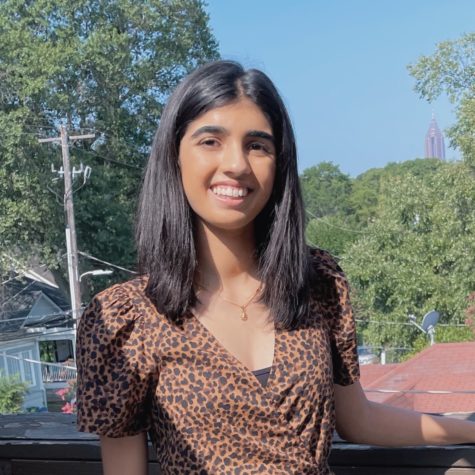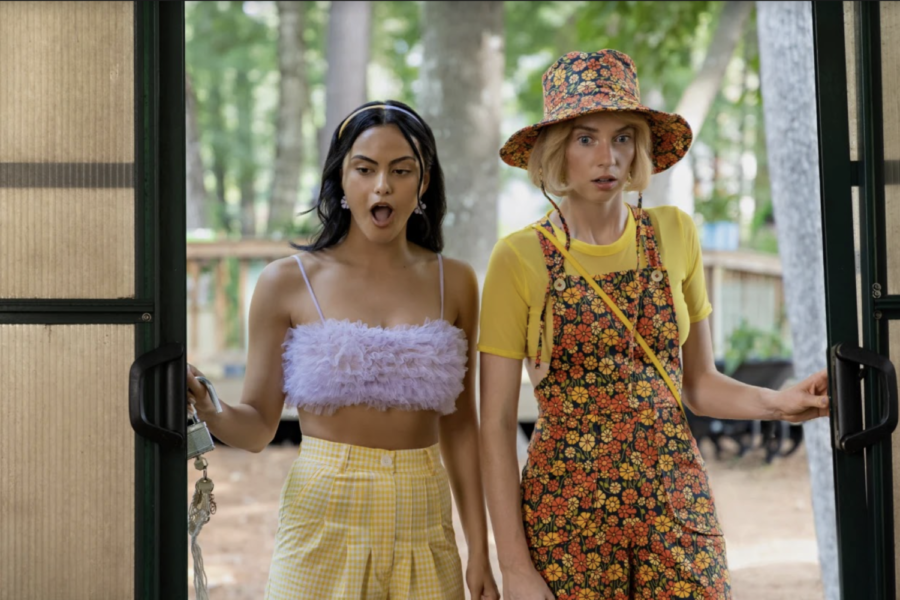“Do Revenge” is a dark love letter to its own genre
Camila Mendes’ Drea (left) and Maya Hawkes’ Eleanor (right) stumble upon more than one dark secret over the course of Netflix’s new teen comedy “Do Revenge.”
Netflix recently released “Do Revenge,” a dark teen comedy that follows two teenage protagonists, Drea (Camila Mendes) and Eleanor (Maya Hawke) as they team up and plot to “do each other’s revenge.” Drea wants to get back at her ex-boyfriend Max (Austin Abrams), who leaked her nude video to the school but claims that he was hacked. Eleanor wants payback on her childhood summer camp bully, Carissa (Ava Capri).
The film follows both Eleanor and Drea’s perspectives as they pursue vengeance and develop their friendship.
The movie’s cast is certainly recognizable, with its main and supporting characters alike known for their previous roles in popular teen and adult shows. Mendes is known for her role as Veronica in “Riverdale,” Hawke is known for being Robin in “Stranger Things” and other cast members come from “Outer Banks,” “Euphoria,” “13 Reasons Why,” “Game of Thrones,” “Alexa and Katie,” “Ms. Marvel” and more. Mendes is typecast as the mean girl, similar to her role in “Riverdale”; however, most of the other cast members separate themselves from their previous roles, resulting in an entertaining watch for the cast alone. Despite them having very little screen time, actors like Jonathan Daviss (Pope from “Outer Banks”) and Sophie Turner (Sansa in “Game of Thrones”) absolutely make their short appearances worthwhile. It was also a nice surprise to see Sarah Michelle Gellar—known for her roles in “Buffy the Vampire Slayer” and the live-action “Scooby-Doo” movie—playing the headmistress. It’s an amusing and diverse cast, with multiple people of color in non-stereotypical roles. It would have been nice, however, if the film could have featured more up-and-coming actors and actresses, just to increase the cast variety.
One of the major tropes from the genre that “Do Revenge” beautifully adapts for their audience is that of the “gay best friend.” In the ‘90s and ‘00s, there was almost always one male character that served as the coming-of-age film’s only positive queer representation. All they really did was emotionally support the main character—think Damian in “Mean Girls” or Christian in “Clueless”. In “Do Revenge,” the focus was shifted toward gay female representation, with three of the main female characters in the film being openly queer, including Eleanor. It’s amazing to see a film from this genre finally taking a step away from the stereotype of the “gay best friend” and opt for a more accurate portrayal of queer people—specifically queer women, who are often underrepresented.
However, what really sets this film apart from a lot of other recent coming-of-age movies is that it expertly blends several different ‘90s and ‘00s movies of the same genre. We don’t want to give any spoilers, but the film has a major twist that we definitely were not expecting. In this sense, “Do Revenge” takes the themes and tropes of these cult classics and creates a fresh and updated version for the 2020s, highlighting the best aspects of the genre. Inspiration seems to be drawn from “Mean Girls,” with their distinctions of high school cliques—now including things like Greta Thunburg obsessors, Instagram witches and the classic mean girls—as well as the makeover montage from “Clueless” and some dark humor elements from “Heathers,” among others. Even the appearance of Y2K it-girl Sarah Michelle Gellar is an homage to that era. The movie is just packed with everything you could want from a guilty pleasure teen comedy: romance, drama and the complexities of friendship between high school girls.
Although the character choices and tropes are memorable, the costume design throughout the film is probably one of its most notable features. At the private high school that the students attend, everyone wears preppy pastel green and purple uniforms, with most girls sporting a pleated plaid skirt—likely another homage to “Clueless.” But, you can still get a feel for each character’s personality and identity, even when they are in their uniforms. Their trendy accessories and shoes, as well as the uniform pieces that they choose to wear, allow parts of each character to be portrayed physically. For example, many of the queer female characters opt to wear the khaki pants and sweaters that the boys of the school usually wear.
The scenes outside of school are truly where the costume department shines. Costume designer Alana Moreshead hits the nail on the head with each individual character’s style, especially Drea and Eleanor. Throughout the film, Drea is dressed in incredibly elaborate, bright and well-put-together feminine outfits, showing her perfectionist nature—in her own words, “[Drea] spent 17 years meticulously curating the perfect life.” However, in scenes where she is struggling mentally, Drea’s outfits are quite toned down. This is likely because her outfits also serve as a sort of emotional guard to make her seem tough yet proper. On the contrary, Eleanor’s style is much more androgynous and starts out a bit disheveled. This changes when Drea gives her a makeover and we see Eleanor develop her cool-girl persona with touches of her queer and quirky personality mixed in. Another noteworthy aspect of the costume design is simply the fact that Moreshead made a point to feature a lot of independent, woman-owned businesses and brands in her costuming choices. The amount of thought that went into the costume design for each individual character did not go unnoticed, and we really enjoyed how much the unique pieces contributed to the overall aesthetic of the highly stylized film.
Another aspect outside of the plot that needs to be discussed is the film’s immaculate soundtrack. Of course, the movie has a ton of different modern bangers including songs like Olivia Rodrigo’s angsty track “brutal,” “CYBAH” from Syd’s most recent R&B album, Caroline Palochek’s “So Hot You’re Hurting my Feelings” and the iconic MUNA and Phoebe Bridgers queer collab “Silk Chiffon.” But the film also cites its genre’s forefathers yet again through the inclusion of several ‘90s and early 2000s bops. For example, you can hear “The Impression That I Get” by the ska band The Mighty Mighty Bosstones, as well as a cover of “Kids in America,” sung by Maude Latour. These can be directly linked to the movie “Clueless.” The Mighty Mighty Bosstones actually make an appearance in the film when Cher and her friends go dancing , with “Kids in America” being the song that plays during the opening scene. Outside of those two songs, the soundtrack has plenty of other turn-of-the-century tunes like “Deceptacon” by Le Tigre, “Celebrity Skin” by Hole and “Dreams” by The Cranberries, all of which teem with ‘90s/Y2K teen girl vibes. Overall, this soundtrack really is the cherry on top of a fantastic homage to the teenage girl coming-of-age genre.
While there are multiple positives to the movie, there are also some critiques to be made—mainly with the dialogue and somewhat rushed ending. Yes, there are plenty of iconic and witty lines, but there are definitely just as many cringe-worthy moments. Furthermore, the last 30 or so minutes of the movie felt extremely rushed and tied together too neatly, undermining the unpredictable plot twist. “Do Revenge” certainly isn’t representative of real high schoolers—similar to other teen shows like “Euphoria”—and our main characters are problematic and, at times, unlikeable. However, the film is definitely worth a watch, especially to appreciate the cast, costumes, soundtrack and of course, the plot twist. “Do Revenge” is girls-night-in approved, so grab your PJs, your besties and your popcorn to enjoy this modern take on a classic genre.

Sophia Popkin (she/her) is a senior majoring in political science, with a minor in sociology. Outside of writing and posting on social media for The Observer,...

Karuna Lakhiani (she/her) is a fourth-year student majoring in international studies on the pre-law track with minors in creative writing and economics....


